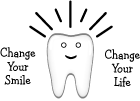Oral Cancer
Your SmilesRForever dentist has good news about progress against cancer. It is now easier than ever to detect oral cancer early, when the opportunity for effective treatment is greatest. Only half of all patients diagnosed with oral cancer survive more than five years.
Your SmilesRForever dentist has the skills and tools to ensure that early signs of cancer and pre-cancerous conditions are identified. You and your dentist can fight and win the battle against oral cancer. Know the early signs and see your dentist regularly.
Oral cancer screening is a routine part of a dental examination. Regular check-ups, including an examination of the entire mouth, are essential in the early detection of cancerous and pre-cancerous conditions. You may have a very small, but dangerous, oral spot or sore and not be aware of it. Your dentist will carefully examine the inside of your mouth and tongue and in some patients may notice a flat, painless, white or red spot or a small sore. Although most of these are harmless, some are not. Harmful oral spots or sores often look identical to those that are harmless, but testing can tell them apart. If you have a sore with a likely cause, your dentist may treat it and ask you to return for re-examination.
Dentists can often notice a spot or sore that looks harmless and does not have a clear cause. To ensure that a spot or sore is not dangerous, your dentist may choose to perform a simple test, such as a BrushTest. As powerful as a pap smear, which detects abnormal cells in women, a BrushTest collects cells from a suspicious lesion in the mouth. The cells are sent to a laboratory for analysis. If precancerous cells are found, the lesion can be surgically removed if necessary during a separate procedure. It’s important to know that all atypical and positive results from a BrushTest must be confirmed by incisional biopsy and histology.
Although methods of early detection are continuously improving, great importance still lies with prevention. The following are a list of recommendations for both prevention and early detection of oral cancer:
- The best way to prevent oral cancer is to avoid tobacco and alcohol use.
- Regular dental check-ups, including an examination of the entire mouth, are essential in the early detection of cancerous and pre-cancerous conditions.
- Many types of abnormal cells can develop in the oral cavity in the form of red or white spots. Some are harmless and benign, some are cancerous and others are pre-cancerous, meaning they can develop into cancer if not detected early and removed.
- Finding and removing epithelial dysplasias before they become cancer can be one of the most effective methods for reducing the incidence and mortality of cancer.
- Knowing the risk factors and seeing your dentist for oral cancer screenings can help prevent this deadly disease. Routine use of the Pap smear since 1955, for example, dramatically reduced the incidence and mortality rates for cervical cancer in the United States.
- Similarly, use of colonoscopy now makes it possible to detect dysplastic polyps years before they can turn into colon cancer and is contributing to falling rates of mortality for the disease.
- Oral cancer is often preceded by the presence of clinically identifiable premalignant changes. These lesions may present as either white or red patches or spots. Identifying white and red spots that show dysplasia and removing them before they become cancer is an effective method for reducing the incidence and mortality of cancer.
Visit your SmilesRForever dentist at least twice a year for biannual cleanings; an oral cancer screening will be performed at each of these appointments. Together you and your SmilesRForever dentist can work to prevent and detect oral cancer.

